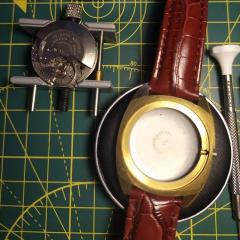Vestal Roosevelt 316L front cover / crystal removal
-
Similar Content
-
Recently Browsing
- No registered users viewing this page.
-
Topics
-
Posts
-
By Terrinecold · Posted
Welcome. I am also French but living in Waltham Massachusetts near Boston. -
I've just finished servicing a JLC P478. When I got the watch it was missing the top balance jewels (endstone and cap). I ordered what I thought was the right jewels from Cousins, but what arrived was a jewel in a big brass setting with two screw holes, as if for non-shock proof movement. So I decided to try swapping in jewels from other movements to see if any would work. I tried jewels that matched the diameter of the bottom balance jewels of the JLC- like the Seiko 6119, or Incablocs fro ETA movements, but they were the wrong depth. I ended up with the jewels from a FHF 905. They had a slightly smaller diameter than the JLC ones but they fitted depth-wise perfectly, and the watch ran. But....the watch runs very well in all positions except for two of the vertical positions. I'm talking 290 degrees DU, DD, CD, CL, dropping to 150 degrees CU and CR. So the first question is: could ill-fitting jewels on one end of the balance cause this? If yes, then it would be good to get the correct jewels. I'm not familiar with JLC movements, so if anyone knows what the correct ones are then that would be great.
-
By DanielCampbel · Posted
This happens because the air inside the watch expands and contracts, creating moisture. replica watches are more prone to condensation problems because they may not have the same level of quality and precision in their seals as authentic watches. So, to minimize condensation, it's essential to avoid exposing your replica watch to extreme temperature changes. Regular servicing is also crucial. This helps maintain the integrity of the seals and ensures that your watch is in good working condition. If you notice condensation in your replica watch, it's best to take it to a professional watchmaker for inspection and repair. -
Your general point is well made, but in my case I was talking about the teeny 0.2ml vials, e.g. 9010 for £6.87. This is considerably worse value for money unless this is all you need, in which case it's great! When you multiply by the ~5 different kinds of lubricant you need, it makes a big difference for a beginner. 0.2ml is plenty for a leisurely tinkerer as long as you're careful not to spill it! I made a little stand for the vials by drilling holes in a plastic bottle top. Then I carefully transfer a drop or two from an upright vial to a covered oiling cup using a large oiler as debated in another thread here.
-









Recommended Posts